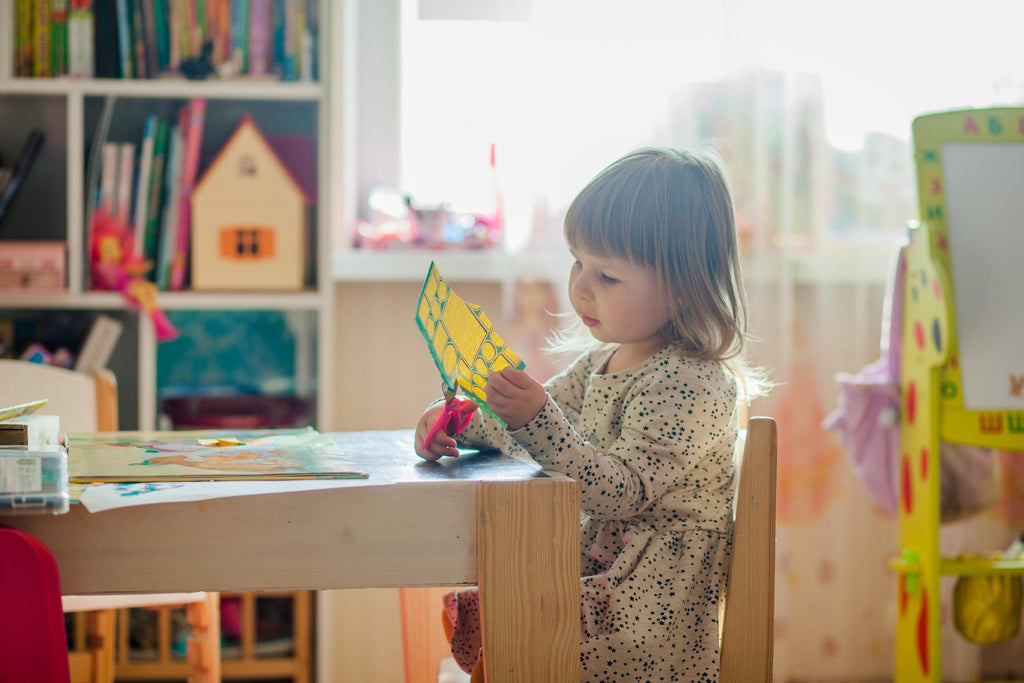Children are active, curious, creative and energetic beings! Energy and excitement are good things and should be acknowledged; however, there are times when focus and attention are put to the test. Children are asked to remain seated for long periods of time. They are told not to wiggle or move out of the ‘crisscross-apple-sauce’ position. They are told to keep their arms and feet to themselves and to not stomp or touch things.
Let’s be real...I’m in my 30’s and I constantly move and fidget. So how can we expect our children, whom we know naturally seek extra input, to sit still in the classroom…. It’s not going to happen!
Strategies can be implemented to assist in creating a successful classroom atmosphere for all children. What can you put in your sensory toolbox to facilitate success for students in the classroom? There are a vast array of sensory strategies that can be used in a classroom to improve focus and regulation. The benefits of these sensory tools for students have been shown to promote participation, learning, and growth for all children.
- Get Moving: Sitting for too long can cause mental, as well as, physical health problems. Circle time or seated activities must be kept to a minimum. During this time children should be allowed to wiggle, move safely and appropriately. Make active movement an integral part of lessons and encourage children to change positions frequently.
-
Sensory Activity: Sensory activity ideas are endless. Let your child find 10 hidden objects in a sensory bin (rice, beans, sand, water beads - to name a few). Practice handwriting or math using shaving cream. Incorporate a hands-on portion of your science lessons. Instruct the children to plant and understand the water cycle during which time kids garden in the dirt and engage in water play. Get those busy hands active and engaged.

- Heavy work: This can be done in many ways. Try to have the line leader hold a heavy door for all the kids as they exit. Another alternative: request the children carry a few (appropriately weighted. Consider an active break after sitting for more than 10 minutes: Request the class complete 10 chair push-ups (holding the edge of the chair with their arms, lifting their feet and bottoms off their chair).
- Active Sitting: Read my blog about Wiggle seats! There are many options for active sitting that allow for movement and provide children with the sufficient input, which they are seeking. Many of these options are discrete and can be done by one child or the entire class. Some of these options are sitting on an exercise ball, a wobble stool or cushion, an inflated wedge, or using a foot band.
- Fidget Toys: You can make a bin full of fidget toys. Each time they use them, request the children to select his or her preference. Some fidget ideas are: fidget cubes, mesh marble toys, putty, Koosh ball, anti-stress balls, spinner, pencil fidget topper.
- Lighting Modifications: Please refer to my blog: Sensory lighting Do’s and Don'ts. Light modifications can make a significant impact upon a child's performance. Most classrooms, unfortunately, have fluorescent lighting--if they don’t you are in luck! If possible, be in natural, indirect light. Be aware of reflections both from windows and doors, as well as the floor (carpets/rugs are less noxious for light sensitive children).
- Vestibular Input: This type of input can be highly beneficial to prepare children’s’ minds and bodies to learn. Some ideas for vestibular input in the classroom are: a rocking chair, inverted positions (ex. down dog, touching toes), marching, animal walks and rocking slowly on an exercise ball. You can play the game ‘Simon says’, head shoulders knees and toes, pass a ball overhead and then through your legs, scooter board through the hallway to deliver a note to another teacher. Get your body moving!
-
Weighted Tools (Lap pads, Blankets, Animals): These can be especially beneficial during tabletop seated activities. Simply plop a weighted lap pad, blanket or stuffed animal in the child's lap and get to work. A child can carry these objects during transitions when walking through the hallways.

- Snacks: What child doesn't love snack time! Oral motor input through snacks can be a wonderful (and discrete) way to organize children. Try hard crunchy foods like pretzel rods, carrot sticks, crunchy apples, dried fruit or cucumbers.
- Reduce Visual Stimulation: As tempting as it is for teachers to fill their classrooms with colorful objects and signs on the walls - this is where less is truly more! Too much visual input can be distracting and disorganizing for children. Windows and doors are also important as outside activity can quickly take a child's attention; position desks/tables with children’s’ backs to windows and doors.
- Transitional Aids: Having a visual schedule for the day's activities is a wonderful tool to provide awareness and anticipatory knowledge for children. Auditory timers are also perfect transitional aids (ex. “When you hear the timer we are all done and will begin our next activity”.)
- Quiet Corner: This can be a place to sit, wiggle, lie down, curl up (whatever position your body needs). It is an ideal opportunity provided to create a peaceful, relaxation moment to regain control and modulation. Calming tools to incorporate here can be pillows, weighted items, dim lighting, and fidgets.





Leave a comment: